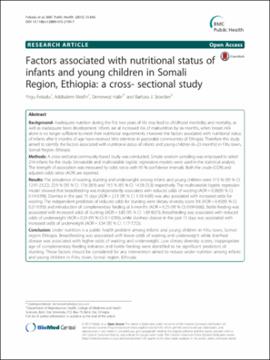| dc.contributor.author | Fekadu, Yirgu | |
| dc.contributor.author | Mesfin, Addisalem | |
| dc.contributor.author | Haile, Demewoz | |
| dc.contributor.author | Stoecker, Barbara J. | |
| dc.date.accessioned | 2019-08-21T22:01:38Z | |
| dc.date.available | 2019-08-21T22:01:38Z | |
| dc.date.issued | 2015-09-02 | |
| dc.identifier | oksd_fekadu_factorsassocia_2015-09-02 | |
| dc.identifier.citation | Fekadu, Y., Mesfin, A., Haile, D., & Stoecker, B. J. (2015). Factors associated with nutritional status of infants and young children in Somali Region, Ethiopia: a cross-sectional study. BMC Public Health, 15(1). https://doi.org/10.1186/s12889-015-2190-7 | |
| dc.identifier.uri | https://hdl.handle.net/11244/321218 | |
| dc.description.abstract | Background: Inadequate nutrition during the first two years of life may lead to childhood morbidity and mortality, as well as inadequate brain development. Infants are at increased risk of malnutrition by six months, when breast milk alone is no longer sufficient to meet their nutritional requirements. However the factors associated with nutritional status of infants after 6 months of age have received little attention in pastoralist communities of Ethiopia. Therefore this study aimed to identify the factors associated with nutritional status of infants and young children (6-23 months) in Filtu town, Somali Region, Ethiopia. | |
| dc.description.abstract | Methods: A cross-sectional community-based study was conducted. Simple random sampling was employed to select 214 infants for the study. Univariable and multivariable logistic regressions models were used in the statistical analysis. The strength of association was measured by odds ratios with 95 % confidence intervals. Both the crude (COR) and adjusted odds ratios (AOR) are reported. | |
| dc.description.abstract | Results: The prevalence of wasting, stunting and underweight among infants and young children were 17.5 % (95 % CI: 12.91-23.22), 22.9 % (95 % CI: 17.6-28.9) and 19.5 % (95 % CI: 14.58-25.3) respectively. The multivariable logistic regression model showed that breastfeeding was independently associated with reduced odds of wasting (AOR = 0.38(95 % CI: 0.14-0.99)). Diarrhea in the past 15 days (AOR = 2.13 (95 % CI: 1.55-4.69)) was also associated with increased odds for wasting. The independent predictors of reduced odds for stunting were dietary diversity score ≥4 (AOR = 0.45(95 % CI: 0.21-0.95)) and introduction of complementary feeding at 6 months (AOR = 0.25 (95 % CI: 0.09-0.66)). Bottle feeding was associated with increased odds of stunting (AOR = 3.83 (95 % CI: 1.69-8.67)). Breastfeeding was associated with reduced odds of underweight (AOR = 0.24 (95 % CI: 0.1-0.59)), while diarrheal disease in the past 15 days was associated with increased odds of underweight (AOR = 3.54 (95 % CI: 1.17-7.72)). | |
| dc.description.abstract | Conclusion: Under nutrition is a public health problem among infants and young children in Filtu town, Somali region Ethiopia. Breastfeeding was associated with lower odds of wasting and underweight while diarrheal disease was associated with higher odds of wasting and underweight. Low dietary diversity scores, inappropriate age of complementary feeding initiation and bottle feeding were identified to be significant predictors of stunting. Those factors should be considered for any intervention aimed to reduce under nutrition among infants and young children in Filitu town, Somali region, Ethiopia. | |
| dc.format | application/pdf | |
| dc.language | en_US | |
| dc.publisher | BioMed Central | |
| dc.rights | This material has been previously published. In the Oklahoma State University Library's institutional repository this version is made available through the open access principles and the terms of agreement/consent between the author(s) and the publisher. The permission policy on the use, reproduction or distribution of the material falls under fair use for educational, scholarship, and research purposes. Contact Digital Resources and Discovery Services at lib-dls@okstate.edu or 405-744-9161 for further information. | |
| dc.title | Factors associated with nutritional status of infants and young children in Somali Region, Ethiopia: a cross- sectional study | |
| osu.filename | oksd_fekadu_factorsassocia_2015-09-02.pdf | |
| dc.description.peerreview | Peer reviewed | |
| dc.identifier.doi | 10.1186/s12889-015-2190-7 | |
| dc.description.department | Nutritional Sciences | |
| dc.type.genre | Article | |
| dc.type.material | Text | |
| dc.subject.keywords | bottle feeding | |
| dc.subject.keywords | breast feeding | |
| dc.subject.keywords | cross-sectional studies | |
| dc.subject.keywords | diarrhea | |
| dc.subject.keywords | diet | |
| dc.subject.keywords | ethiopia | |
| dc.subject.keywords | female | |
| dc.subject.keywords | humans | |
| dc.subject.keywords | infant | |
| dc.subject.keywords | infant nutrition disorders | |
| dc.subject.keywords | logistic models | |
| dc.subject.keywords | male | |
| dc.subject.keywords | nutrition disorders | |
| dc.subject.keywords | nutritional requirements | |
| dc.subject.keywords | nutritional status | |
| dc.subject.keywords | odds ratio | |
| dc.subject.keywords | prevalence | |
| dc.subject.keywords | residence characteristics | |
| dc.subject.keywords | socioeconomic factors | |
| dc.subject.keywords | thinness | |
